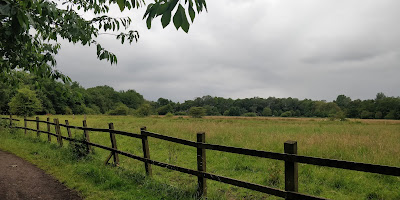 |
| Juvenile robin, Stretford |
It was a cooler, grey and muggy Saturday, the blackbird and the blackcap were singing in the sycamores, the woodpigeons singing on the rooftops and the wren from somewhere deep in the blackcurrants. The cat had gone for a pee, the wren registered a complaint by flying to the open window and letting me know about it. I let the cat back in, the wren hopped back over to the blackcurrants, all was well with the world. All that singing prompted the robin to assay a quick burst on its own account. I'd not seen or heard any of the local adult robins for a couple of weeks, a juvenile's a regular in the rose bushes in the back.
 |
| Juvenile house sparrow, Stretford |
Next door has had all the trees cut down in his garden which hasn't gone down well with the spadgers, they can't hop from their bramble patch on the railway line to my garden without breaking cover. On the plus side it makes it considerably easier for me to see them coming in. It's a bit spooky when bird food disappears by invisible agency in the middle of the day. The last batch of youngsters are growing up now and have mostly lost their yellow gapes though they're still under the supervision of an old cock sparrow. I thought a few more were rummaging about in the boysenberries but on close inspection turned out to be a few baby long-tailed tits. They're always a treat to see when they turn up.
 |
| Juvenile long-tailed tit, Stretford |
I decided on a wander that didn't involve trains or buses, just because. I wandered over to Cob Kiln Wood, blackbirds singing all the way. You wonder how they have the energy. At the entrance at the end of Torbay Road they were joined by chiffchaffs, dunnocks and a song thrush. A pair of blackcaps churred at me until I was well enough away from their patch. A few ring-necked parakeets screeched in the treetops over by the stables.
 |
| Cob Kiln Wood — the bridge over Old Eeas Brook |
Walking through the wood it was more what I wasn't hearing or seeing that was striking. Any other time of year it would be difficult not to see any titmice or robins. I heard a blue tit churr at me from somewhere deep in a hawthorn bush and saw the silhouette of a robin as it disappeared under an elderflower bush. The adults are in post-breeding moult, keeping in deep cover during the dangerous stage when the flight feathers aren't in best working nick, and the youngsters for the most part are still hanging round with them.
 |
| Cob Kiln Wood approaching the clearing |
The electricity pylon clearing was waist-high in grass and comfrey. A small flock of swallows passed over, a couple of swifts hawked overhead and a whitethroat assayed a bit of song at the woodland margins.
I walked down Cob Kiln Lane into Urmston, woodpigeons clattering about in the trees, blackbirds and chiffchaffs singing and magpies bouncing about the hedgerows. A couple of young chiffchaffs flew across the lane barely missing my head. Looking round the paddocks there were more magpies and a couple of carrion crows.
I walked round to Eeasbrook and followed it down past the cemetery. More blackbirds, chiffchaffs and song thrushes sang, joined by wrens and chaffinches in the cemetery. Robins furtively poked about in the margins of the paddocks as I passed and parakeets wheeled about the trees beyond.
 |
| Urmston Meadows |
I had more luck with titmice and robins in the woodland of Urmston Meadows. I heard a blue tit and a great tit and a robin singing. Magpies and blackbirds fossicked about in the fields, both having a few juveniles amongst them. A ringlet fluttering low in the tall grass was the only butterfly of the day.
As I left the meadows a family of jays bid me good riddance from the safety of a tree by the gate.
The evening brought the first of the big gull flocks of Autumn on the school playing field: forty-four black-headed gulls, twenty-one lesser black-backs and four herring gulls padding away at the damp grass. In a few weeks we'll be seeing the first of the common gulls and so the cycle repeats itself.

No comments:
Post a Comment